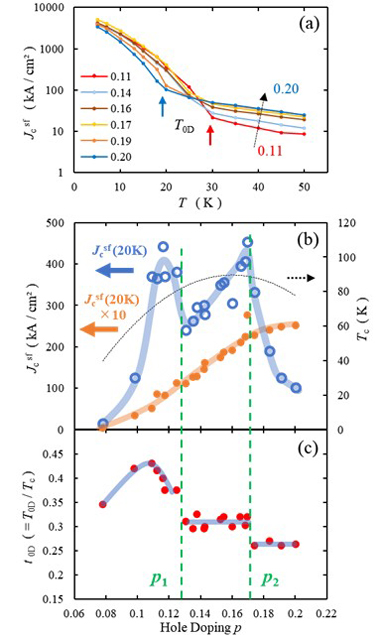PC10-4
Implications of the doping dependence of critical current density for the electronic phase diagram in Bi2.2Sr1.8CaCu2O8+δ single crystals
*Junichiro Kato1,2, Yutaro Mino1, Sugali Pavan Kumar Naik1,2, Taichiro Nishio1, Shungo Nakagawa2,3, Takanari Kashiwagi3, Hiroshi Eisaki2, Shigeyuki Ishida2
- Tokyo University of Science, 1-3 Kagurazaka, Shinjuku, Tokyo 162-8601, Japan1
- National Institute of Advanced Industrial Science and Technology, Tsukuba, Ibaraki 305-8568, Japan2
- University of Tsukuba, 1-1-1 Tennodai, Tsukuba, Ibaraki 305-8573, Japan3
High-critical-temperature (high-Tc) cuprates exhibit a complex electronic phase diagram where multiple quantum phases, e.g. superconductivity, charge order, and spin order, compete or coexist [1]. In such a system, it is important to elucidate the doping level where the phase transition occurs at zero temperature, that is, a quantum critical point (QCP) lying beneath the superconducting dome. For example, doping dependences of Tc and upper critical field of cuprates have been intensively investigated and their unusual behaviors have been discussed in connection with QCPs [2,3]. Moreover, recent studies on several quantum critical superconductors including cuprates [4.5], heavy fermion superconductors [6], and iron-based superconductors [7,8], have revealed that the critical current density (Jc) is sharply enhanced around a QCP, demonstrating that Jc can be a powerful tool to investigate a hidden QCP inside the superconducting dome. However, the doping dependence of Jc should be carefully discussed because in general, Jc is significantly affected by the defect structures (pinning centers), which are often extrinsic in origin. In this study, we systematically investigated the doping dependence of Jc using a Bi2Sr2CaCu2O8+d (Bi2212) single crystal.
Firstly, we demonstrated that a reliable data set can be obtained by repeating the measurement and the control of the doping level on the same crystal, which is expected to reduce the uncertain factors affecting Jc such as crystal quality, chemical compositions, and sample shape. Fig. (a) shows the temperature (T) dependence of Jc at the self field (Jcsf) for representative doping levels. At any doping level, a sudden change in the T dependence of Jcsf (Jcsf – T) was observed (a kink feature indicated by arrows in Fig. (a) and the T is defined as T0D). As shown in Fig. (a), T0D is doping dependent, resulting in the crossing behavior of Jcsf – T curves at different doping levels. As a result, the doping dependence of Jcsf (Jcsf – p) significantly depends on T as shown in Fig. (b). At high temperatures above T0D (50 K (orange circles)), Jc increases with increasing doping, which agrees with those in previous reports [4.5], and is usually associated with the increase in the condensation energy and the decrease in the anisotropy. On the other hand, at low temperatures below T0D (20 K (blue open circles)), the Jcsf – p curve is characterized by the two peaks located at the underdoped region and the slightly overdoped region, which has never been reported so far.
Then, we focus on the doping dependence of T0D, which seems to be closely correlated with the change in Jcsf – p. It should be noted that T0D has been associated with the change in the dimensionality of vortices. In a strongly anisotropic layered superconductor, it has been discussed that a flux line (a one-dimensional object) becomes a vortex pancake (a zero-dimensional object) when the pinning correlation length (Lc) becomes shorter than the interlayer distance (d) [9]. T0D is considered to be the crossover T where Lc ~ d [10,11] and thus inversely correlated with Lc, which can be described as Lc ~ ξ /γ × (Jd /Jc)1/2 where ξ is the coherence length, γ (> 1) is the anisotropy parameter, and Jd is the depairing current density. Fig. (c) shows the doping dependence of T0D normalized by Tc (T0D /Tc). We found that the doping dependence of T0D /Tc shows a sudden jump at around p1 ~ 0.13 and p2 ~ 0.17, where Jc-sf also shows a sudden change (Fig. (b)). The jump in T0D indicates a discontinuous change in the fundamental parameters (e.g. ξ, γ, and/or Jd) and/or the pinning landscape (reflected in Jc). Such a discontinuous change suggests the existence of a phase transition, namely, a QCP. When the doping dependences of Jc and T0D are compared with the phase diagram of cuprates [1], the observed p1 and p2 seem to correspond to the end points of the charge order phase and the pseudogap, respectively. Thus, it is demonstrated that the QCPs hidden beneath the superconducting dome of Bi2212 system are successfully exposed by the precise Jc measurements, although further studies are necessary to confirm the correspondence between these doping levels (p1 and p2) and QCPs.
[1] B.Keimer, et al. Nature 518, 179186 (2015)
[2] G.Grissonnanche, et al. Nat. Commun. 5, 3280 (2014)
[3] M.K.Chan, et. al. PNAS 117, 9782 (2020)
[4] J.L.Tallon, et al. Phys. Stat. Sol. (b) 215, 531 (1999)
[5] M.Naamneh, et al. Phys. Rev. B 90, 224501 (2014)
[6] S.G.Jung. et al. Nat. Commun. 9, 434 (2018)
[7] D.Song, et al. Sci. Rep. 6, 26671 (2016)
[8] S.Ishida, et al. Phys. Rev. B 95, 014517 (2017)
[9] G.Blatter, et al. Rev. Mod. Phys. 66, 1125 (1994)
[10] M.Nideröst, et al. Phys. Rev. B 53, 9286 (1996)
[11] V.F.Correa, et al. Phys. Rev. B 63, 092502 (2001)
(a) Temperature dependence of Jcsf of Bi2212 at representative doping levels (p = 0.11-0.20). T0D is defined as the temperature where a kink appears indicated by arrows.
(b) Doping dependence of Jcsf at 20 K (blue open circles) and 50 K (orange circles, multiplied by 10). Dashed line indicates Tc dome.
(c) Doping dependence T0D normalized by Tc.
Keywords: Cuprate High-Tc Superconductor, Bi2212 Single Crystals, Critical Current Density, Electronic Phase Diagram
